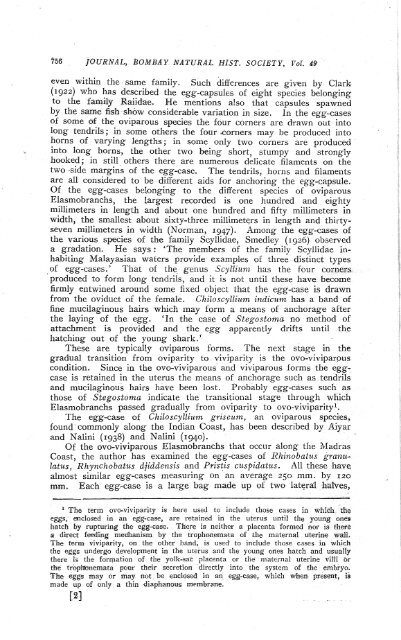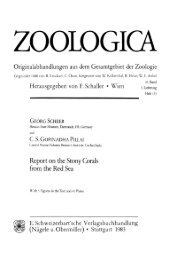observations on the egg-cases of some ovo ... - Eprints@CMFRI
observations on the egg-cases of some ovo ... - Eprints@CMFRI
observations on the egg-cases of some ovo ... - Eprints@CMFRI
You also want an ePaper? Increase the reach of your titles
YUMPU automatically turns print PDFs into web optimized ePapers that Google loves.
756 JOURNAL, BOMBAY NATURAL HIST. SOCIETY, Vol. 49<br />
even within <strong>the</strong> same family. Such differences are given by Clark<br />
(1922) who has described <strong>the</strong> <strong>egg</strong>-capsules <strong>of</strong> eight species bel<strong>on</strong>ging<br />
to <strong>the</strong> family Raiidae. He menti<strong>on</strong>s also that capsules spawned<br />
by <strong>the</strong> same fish show c<strong>on</strong>siderable variati<strong>on</strong> in size. In <strong>the</strong> <strong>egg</strong>-<strong>cases</strong><br />
<strong>of</strong> <strong>some</strong> <strong>of</strong> <strong>the</strong> oviparous species <strong>the</strong> four corners are drawn out into<br />
l<strong>on</strong>g tendrils; in <strong>some</strong> o<strong>the</strong>rs <strong>the</strong> four .corners may be produced into<br />
horns <strong>of</strong> varying lengths; in <strong>some</strong> <strong>on</strong>ly two corners are produced<br />
into l<strong>on</strong>g horns, <strong>the</strong> o<strong>the</strong>r two being short, stumpy and str<strong>on</strong>gly<br />
hooked; in still o<strong>the</strong>rs <strong>the</strong>re are numerous delicate filaments <strong>on</strong> <strong>the</strong><br />
two -side margins <strong>of</strong> <strong>the</strong> <strong>egg</strong>-case. The tendrils, horns and filaments<br />
are all c<strong>on</strong>sidered to be different aids for anchoring <strong>the</strong> <strong>egg</strong>-capsule.<br />
Of <strong>the</strong> <strong>egg</strong>-<strong>cases</strong> bel<strong>on</strong>ging to <strong>the</strong> different species <strong>of</strong> oviparous<br />
Elasmobranchs, <strong>the</strong> largest recorded is <strong>on</strong>e hundred and eighty<br />
millimeters in length and about <strong>on</strong>e hundred and fifty millimeters in<br />
width, <strong>the</strong> smallest about sixty-three millimeters in length and thirtyseven<br />
millimeters in width (Norman, 1947). Am<strong>on</strong>g <strong>the</strong> <strong>egg</strong>-<strong>cases</strong> <strong>of</strong><br />
<strong>the</strong> various species <strong>of</strong> <strong>the</strong> family Scyllidae, Smedley (1926) observed<br />
a gradati<strong>on</strong>. He says : 'The members <strong>of</strong> <strong>the</strong> family Scyllidae inhabiting<br />
Malayasian waters provide examples <strong>of</strong> three distinct types<br />
<strong>of</strong> <strong>egg</strong>-<strong>cases</strong>.' That <strong>of</strong> <strong>the</strong> genus Scyllium has <strong>the</strong> four corners<br />
produced to form l<strong>on</strong>g tendrils, and it is not until <strong>the</strong>se have become<br />
firmly entwined around <strong>some</strong> fixed object that <strong>the</strong> <strong>egg</strong>-case is drawn<br />
from <strong>the</strong> oviduct <strong>of</strong> <strong>the</strong> female. Chiloscyllium indicum has a band <strong>of</strong><br />
fine mucilaginous hairs which may form a means <strong>of</strong> anchorage after<br />
<strong>the</strong> laying <strong>of</strong> <strong>the</strong> <strong>egg</strong>. 'In <strong>the</strong> case <strong>of</strong> Stegostoma no method <strong>of</strong><br />
attachment is provided and <strong>the</strong> <strong>egg</strong> apparently drifts until <strong>the</strong><br />
hatching out <strong>of</strong> <strong>the</strong> young shark.'<br />
These are typically oviparous forms. The next stage in <strong>the</strong><br />
gradual transiti<strong>on</strong> from oviparity to viviparity is <strong>the</strong> <strong>ovo</strong>-viviparous<br />
c<strong>on</strong>diti<strong>on</strong>. Since in <strong>the</strong> <strong>ovo</strong>-viviparous and viviparous forms <strong>the</strong> <strong>egg</strong>case<br />
is retained in <strong>the</strong> uterus <strong>the</strong> means <strong>of</strong> anchorage such as tendrils<br />
and mucilaginous hairs have been lost. Probably <strong>egg</strong>-<strong>cases</strong> such as<br />
those <strong>of</strong> Stegostoma indicate <strong>the</strong> transiti<strong>on</strong>al stage through which<br />
Elasmobranchs passed gradually from oviparity to <strong>ovo</strong>-viviparityl.<br />
The <strong>egg</strong>-case <strong>of</strong> Chiloscyllium griscum, an oviparous species,<br />
found comm<strong>on</strong>ly al<strong>on</strong>g <strong>the</strong> Indian Coast, has been described by Aiyar<br />
and Nalini (1938) and Nalini (1940).<br />
Of <strong>the</strong> <strong>ovo</strong>-viviparous Elasmobranchs that occur al<strong>on</strong>g <strong>the</strong> Madras<br />
Coast, <strong>the</strong> author has examined <strong>the</strong> <strong>egg</strong>-<strong>cases</strong> <strong>of</strong> Rhinobalus granuhaus,<br />
Rhynchobatus djiddensis and Pristis cuspidatus. All <strong>the</strong>se have<br />
almost similar <strong>egg</strong>-<strong>cases</strong> measuring <strong>on</strong> an average 250 mm. by 120<br />
mm. Each <strong>egg</strong>-case is a large bag made up <strong>of</strong> two lateral halves,<br />
1 The term <strong>ovo</strong>-viviparity is here used to include those <strong>cases</strong> in which <strong>the</strong><br />
<strong>egg</strong>s, enclosed in an <strong>egg</strong>-case, are retained in <strong>the</strong> uterus until <strong>the</strong> young <strong>on</strong>es<br />
hatch by rupturing <strong>the</strong> <strong>egg</strong>-case. There is nei<strong>the</strong>r a placenta formed nor is <strong>the</strong>re<br />
a direct feeding mechanism by <strong>the</strong> troph<strong>on</strong>omata <strong>of</strong> <strong>the</strong> maternal uterine wall.<br />
The term viviparity, <strong>on</strong> <strong>the</strong> o<strong>the</strong>r hand, is used to include those <strong>cases</strong> in which<br />
<strong>the</strong> <strong>egg</strong>s undergo development in <strong>the</strong> uterus and <strong>the</strong> young <strong>on</strong>es hatch and usually<br />
<strong>the</strong>re is <strong>the</strong> formati<strong>on</strong> <strong>of</strong> <strong>the</strong> yolk-sac placenta or <strong>the</strong> maternal uterine villi or<br />
<strong>the</strong> trophi<strong>on</strong>emata pour <strong>the</strong>ir secreti<strong>on</strong> directly into <strong>the</strong> system <strong>of</strong> <strong>the</strong> embryo.<br />
The <strong>egg</strong>s may or may not be enclosed in an <strong>egg</strong>-case, which when present, is<br />
made up <strong>of</strong> <strong>on</strong>ly a thin diaphanous membrane.<br />
12]
















